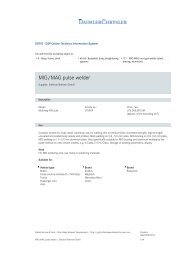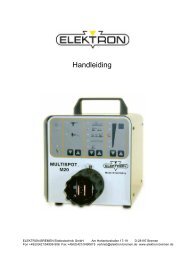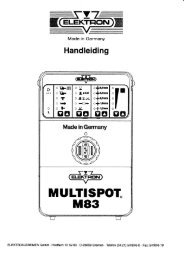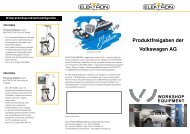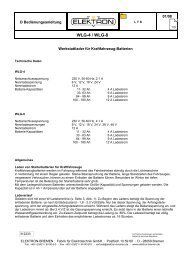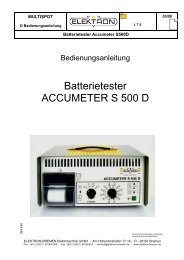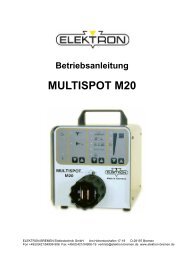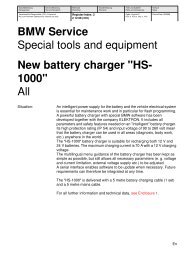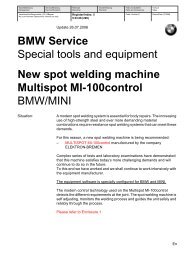Ford Approves Seven Spot Welders for Collision Repair
Ford Approves Seven Spot Welders for Collision Repair
Ford Approves Seven Spot Welders for Collision Repair
Create successful ePaper yourself
Turn your PDF publications into a flip-book with our unique Google optimized e-Paper software.
Monday, July 12, 2004<br />
<strong>Ford</strong> <strong>Approves</strong> <strong>Seven</strong> <strong>Spot</strong> <strong>Welders</strong> <strong>for</strong> <strong>Collision</strong><br />
<strong>Repair</strong><br />
<strong>Ford</strong> Motor Company has approved seven spot welders <strong>for</strong> collision repair use after<br />
completion of an extensive testing program.<br />
The testing program involved analysis of welding strength, button size and peel<br />
tests on galvanized coupons. Tests also were completed using wet and dry<br />
structural adhesives and sealers. The coupons were reviewed <strong>for</strong> button size and<br />
bum back through the adhesives.<br />
The approved spot welders include:<br />
Manufacturer / Contact / <strong>Spot</strong> Welder Model<br />
AMH Canada / www.amh.ca / Model- Compu<strong>Spot</strong> 7001W<br />
Milweld Inc. / 920-779-0916 / Model- Elektron MULTISPOT MI-l00<br />
www.elektron-bremen.de<br />
Pro <strong>Spot</strong> Int'l. Inc. / www.prospot.com / Model- Pro<strong>Spot</strong> PR 10 & Model- Pro<strong>Spot</strong><br />
PR2000<br />
Saitek (Vanguard Technologies) / www.saitek.net / Model- Saitek SK5w & Model-<br />
Saitek SK5<br />
Tecna (Cebotech, Inc.) / www.tecna.net / Model- Tecna ART3650 Inverter<br />
According to John Hughes, Refinish Paint Technical Expert, <strong>Ford</strong> Paint & Body<br />
Technology Center, the recommended spot welders meet the minimum<br />
requirements <strong>for</strong> repairs on <strong>Ford</strong>, Lincoln and Mercury vehicles.<br />
Based on testing results, Hughes has developed a checklist <strong>for</strong> repairers who are<br />
considering the purchase of spot welding equipment. His suggestions and<br />
considerations include:<br />
Electrical Power<br />
<strong>Repair</strong> shops must be electrically equipped to handle resistance welders. Shops<br />
should have minimum 60-amp, 3-phase, 208-volt service to handle most resistance<br />
welding trans<strong>for</strong>mer or inverter equipment.
The distance from breaker box to outlet should always be less than 50 feet. An<br />
acceptable circuit consists of a 60-amp breaker with #6 wire; a better circuit is an<br />
80-amp breaker with #4 wire; the best circuit is a 100-amp breaker using #2 wire.<br />
(Caution: If you have a Delta leg (1 l0v, 1 lOv, 220v compared to normal 3-phase<br />
power of 1 lOv, 1 lOv, 1 lOv), make sure the equipment you purchase works with a<br />
Delta leg.)<br />
Air vs. Liquid-Cooled<br />
Air-cooled welders use air <strong>for</strong> cooling, as well as <strong>for</strong> pincher pressure. Air <strong>for</strong> cooling<br />
and pressure may be continuous or intermittent. Some "continuous" units require<br />
large amounts of compressed air <strong>for</strong> cooling purposes. This can increase electricity<br />
costs. Additionally, some equipment requires high air pressure (1 Sopsi) <strong>for</strong><br />
optimum per<strong>for</strong>mance. Liquid-cooled welders require minimal compressed air.<br />
There are a variety of styles: Some cool welding tips only; some cool tips and<br />
cables only; some cool tips, cables and the inverter; and some cool tips and the<br />
inverter only. Liquid-cooled machines generally have an improved duty cycle and<br />
decreased adhesive bum-back when weld bonding.<br />
Manual vs. Computerized<br />
Manual welders are less expensive than computerized units but require more<br />
training to master. Computerized resistance spot welders are much less complex to<br />
operate.<br />
Gun Tips and Pressure<br />
Tips make a difference. Flat tips are most widely used today. Round tips work well<br />
when welding through adhesive. Conical tips require high maintenance. Tip<br />
pressure also is important. High pressure is required to weld through adhesive<br />
"weld bond". Low tip pressure causes sparks and excessive adhesive bum through.<br />
Welding Through Adhesive<br />
Class A weld bonding requires: Correct tip pressure (high is good; low isn't); proper<br />
amperage; appropriate gun/tip configuration; appropriate weld time; minimum<br />
adhesive bum-back pattern around weld nugget.<br />
Product Support<br />
Products are only as good as the support you are provided. Here are a few<br />
suggested questions you might want to ask: What are the basic warranty provisions<br />
<strong>for</strong> the equipment? How many sales representatives does the company employ?<br />
How many service representatives does it employ? What will my down time be if the<br />
equipment stops working? Does the company offer replacements or loaners? What<br />
are the hours <strong>for</strong> telephone and e-mail support? Does the company provide on-site<br />
technical assistance support?




